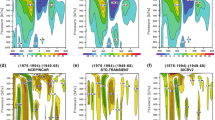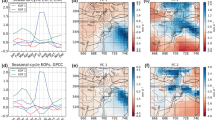Abstract
The generation and dissipation of SST anomalies is mediated by the covariability of SST and surface heat fluxes. The connection between the variability of heat flux (including its radiative and turbulent components) and that of SST is investigated using the NCEP-NCAR and ERA-40 reanalyses and the CMIP3 multi-model collection of climate simulations. The covariance patterns of SST and heat flux are broadly similar in the two reanalyses. The upward heat fluxes are positively correlated with the SST anomalies in the tropics, the northern Pacific mid-latitudes, and over the Gulf Stream, and negatively correlated in the northern subtropics and the SPCZ region. Common covariance features are seen in all climate models in the tropics and the subtropics, while covariances differ considerably among models at northern mid-latitudes, where weak values of the ensemble mean are seen. Lagged covariances are broadly similar in the two reanalyses and among the models, implying that heat flux feedback is also similar. The heat flux feedback parameter is determined from the lagged cross-covariances together with the auto-covariance of SST. Feedback is generally negative and is dominated by the turbulent component. The strongest feedback is found at mid-latitudes in both hemispheres, with the largest values occurring in the western and central portions of the oceans with extensions to higher latitudes. The latter are also areas with large inter-model differences. The heat flux feedback strengthens in winter and fall and weakens in spring and summer. The magnitudes of the annual and seasonal feedback parameters are slightly weaker in most models compared to the reanalysis-based estimates. The mean model feedback parameter has the best pattern correlation and the smallest mean square difference compared to the reanalysis-based values, although spatial variances are weak. Model resolution shows no relationship with the heat flux feedback parameters obtained from model results. The SST-heat flux covariance is decomposed into components associated with surface heat flux feedback and atmospheric forcing processes. Heat flux feedback dominates over the atmospheric forcing and heat flux damps SST anomalies on average at northern Pacific mid-latitudes and southern Atlantic mid-latitudes; while the reverse occurs in the SPCZ and northern Atlantic mid-latitudes.

















Similar content being viewed by others
References
AchutaRao KM, Sperber KR (2006) ENSO simulation in coupled ocean–atmosphere models: are the current models better? Clim Dyn 27:1–15
Alexander MA, Deser C (1995) A mechanism for the recurrence of wintertime midlatitude SST anomalies. J Phys Oceanogr 25:122–137
Barsugli JJ, Battisti DS (1998) The basic effects of atmosphere–ocean thermal coupling on midlatitude variability. J Atmos Sci 55:477–493
Battisti D, Bhatt U, Alexander M (1995) A modeling study of the interannual variability in the wintertime North Atlantic ocean. J Clim 8:3067–3083
Bengtsson L, Hagemann S, Hodges KI (2004) Can climate trends be calculated from reanalysis data? J Geophys Res 109:D11111. doi:10.1029/2004JD004536
Berry DI, Kent EC (2009) A new air–sea interaction gridded dataset from ICOADS with uncertainty estimates. Bull Am Meteor Soc 90:645–656
Boer GJ, Lambert S (2001) Second-order space–time climate difference statistics. Clim Dyn 17:213–218
Bourassa M, Hughes P, Smith S (2008) Surface turbulent flux product comparison. Flux News 5:22–24
Bretherton C, Battisti D (2000) An interpretation of the results from atmospheric general circulation models forced by the time history of the observed sea surface temperature distribution. Geophys Res Lett 27:767–770
Cayan DR (1992) Latent and sensible heat flux anomalies over the northern oceans: driving the sea surface temperature. J Phys Oceanogr 22:859–881
Chou SH, Nelkin E, Ardizzone J, Atlas RM (2004) A comparison of latent heat fluxes over global oceans for four flux products. J Clim 17:3973–3989
Czaja A (2003) On the time variability of the net ocean to atmosphere heat flux in midlatitudes, with application to the North Atlantic basin. Q J R Meterol Soc 129:2867–2878
Frankignoul C (1985) Sea surface temperature anomalies, planetary waves and air–sea feedback in the middle latitudes. Rev Geophys 23:357–390
Frankignoul C, Kestenare E (2002) The surface heat flux feedback. Part I: estimates from observations in the Atlantic and the North Pacific. Clim Dyn 19:633–647
Frankignoul C, Czaja A, Heveder B (1998) Air–sea feedback in the North Atlantic and surface boundary conditions for Ocean models. J Clim 11:2310–2324
Frankignoul C, Kestenare E, Botzet M et al (2004) An intercomparison between the surface heat flux feedback in five coupled models, COADS and the NCEP reanalysis. Clim Dyn 22:373–388
Garreaud RD, Battisti DS (1999) Interannual (ENSO) and interdecadal (ENSO-like) variability in the Southern Hemisphere tropospheric circulation. J Clim 12:2113–2123
Guilyardi E (2006) El Niño—mean state—seasonal cycle interactions in a multi-model ensemble. Clim Dyn 26:329–348
Kanamitsu M, Ebisuzaki W, Woollen J, Yang SK, Hnilo JJ, Fiorino M, Potter GL (2002) NCEP-DOE AMIP-II reanalysis (R-2). Bull Am Meteor Soc 83:1631–1643
Kistler R, co-authors (2001) The NCEP-NCAR 50-year reanalysis: monthly means CD-ROM and documentation. Bull Am Meteor Soc 82:247–268
Kushnir Y, Lau NC (1992) The general circulation model response to a North Pacific SST anomaly: dependence on time scale and pattern polarity. J Clim 5:271–283
Meehl GA, Covey C, Delworth T, Latif M, McAvaney B, Mitchell JFB, Stouffer RJ, Taylor KE (2007) The WCRP CMIP3 multimodel dataset: a new era in climate change research. Bull Am Meteor Soc 88:1383–1394
Merryfield WJ (2006) Changes to ENSO under CO2 doubling in a multimodel ensemble. J Clim 19:4009–4027
Peixoto J, Oort A (1992) The physics of climate. AIP, New York, p 520
Ramanathan V, Collins W (1991) Thermodynamic regulation of ocean warming by cirrus clouds deduced from observations of the 1987 El Niño. Nature 351:27–32
Reichler T, Kim J (2008a) How well do coupled models simulate today’s climate? Bull Am Meteor Soc 89:303–311
Reichler T, Kim J (2008b) Supplement to how well do coupled models simulate today’s climate? Bull Am Meteor Soc 89:ES1–ES6
Ronca RE, Battisti DS (1997) Anomalous sea surface temperatures and local air–sea energy exchange on intraannual timescales in the northeastern subtropical Pacific. J Clim 10:102–117
Saravanan R (1998) Atmospheric low-frequency variability and its relationship to midlatitude SST variability: studies using the NCAR climate system model. J Clim 11:1386–1404
Shapiro R (1971) Smoothing, filtering and boundary effects. Rev Geophys Space Phys 8:359–387
Trenberth KE, Caron JM, Stepaniak DP (2001) The atmospheric energy budget and implications for surface fluxes and ocean heat transports. Clim Dyn 17:259–276
Uppala SM and co-authors (2005) The ERA-40 re-analysis. Q J R Meteor Soc 131:2961–3012
von Storch H, Zwiers FW (1999) Statistical analysis in climate research. Cambridge University Press, Cambridge, p 494
Wang W, McPhaden MJ (2001) What is the mean seasonal cycle of surface heat flux in the equatorial Pacific? J Geophys Res 106:837–857
WCRP (2000) Intercomparison and validation of ocean–atmosphere energy flux fields. WCRP-112, WMO/TD-No. 1036, 303 pp
Wu R, Kirtman BP, Pegion K (2006) Local air–sea relationship in observations and model simulations. J Clim 19:4914–4932
Yu B, Boer GJ (2006) The variance of sea surface temperature and projected changes with global warming. Clim Dyn 26:801–821
Yu L, Weller RA (2007) Objectively analyzed air–sea heat fluxes for the global ice-free oceans (1981–2005). Bull Am Meteor Soc 88:527–539
Yu R, Zhang M, Cess RD (1999) Analysis of the atmospheric energy budget: a consistency study of available data sets. J Geophys Res 104(D8):9655–9661
Acknowledgments
We acknowledge the modeling groups, the Program for Climate Model Diagnosis and Intercomparison (PCMDI) and the WCRP’s Working Group on Coupled Modelling (WGCM) for their roles in making available the WCRP CMIP3 multi-model dataset. Support of this dataset is provided by the Office of Science, US Department of Energy. We are grateful to P. Janssen, V. Swail, and S. Uppala for helpful discussion in understanding the reanalysis results, to S. Lambert and F. Majaess for help with the BLT diagram, and to A. Krol and J. Wang for help in the CMIP data processing. We thank two anonymous reviewers for helpful suggestions and comments on this study.
Author information
Authors and Affiliations
Corresponding author
Rights and permissions
About this article
Cite this article
Yu, B., Boer, G.J., Zwiers, F.W. et al. Covariability of SST and surface heat fluxes in reanalyses and CMIP3 climate models. Clim Dyn 36, 589–605 (2011). https://doi.org/10.1007/s00382-009-0669-6
Received:
Accepted:
Published:
Issue Date:
DOI: https://doi.org/10.1007/s00382-009-0669-6




